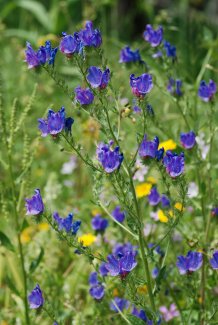Africa
Macaronesia: Portugal - Madeira Islands; Spain - Canary Islands Northern Africa: Algeria; Egypt; Libya; Morocco; Tunisia Asia-Temperate Caucasus: Georgia Western Asia: Cyprus; Israel; Jordan; Lebanon; Syria; Turkey
Europe
East Europe: Ukraine - Krym Middle Europe: Germany Northern Europe: United Kingdom Southeastern Europe: Albania; Bulgaria; Croatia; Greece; Italy; Slovenia Southwestern Europe: France; Portugal; Spain
Listed as an annual or perennial forb by Calflora, and an annual and biennial herb in Jepson.
E. plantagineum is mainly known as a weed of pastures. It is found in parts of the world with a Mediterranean climate. Where introduced it has established and spread successfully in pastures where it can outcompete native species. It is listed as a noxious weed in all states of Australia, and described as invasive in South Africa and countries of South America. E. plantagineum is a softly hairy, winter annual species which produces a bushy paniculate inflorescence of occasionally-branched unilateral cymes, often much enlarging in fruit. In sparse vegetation, E. plantagineum has a rosette of basal leaves and a more prostrate habit compared with the erect habit where plant densities are high.
More frequently described as an annual species. The nomenclature of E. plantagineum has been confused. At various times, the synonyms E. violaceum and E. lycopsis have been used. Lacaita (1919) and Ewart and Tovey (1920), for E. violaceum, and Gibbs (1971), for E. lycopsis, showed that this material was identical to E. plantagineum, the correct name for the species. Misidentifications of Echium material in the literature and herbaria have also been common. E. plantagineum has been determined incorrectly as E. creticum, E. italicum and E. vulgare (Piggin and Sheppard, 1995). Pérez Lara (1889) described var. megalanthus in Spain, but this distinction was not adopted.
E. plantagineum was almost certainly first exported outside its native range intentionally as a garden species. For example, it was probably brought to Australia in the early 19th century as seed, shipped from England, Madeira, the Canary Islands or South Africa on the main shipping route prior to the Suez Canal opening in 1869. E. plantagineum is listed under the name E. violaceum or E. violaceum grandiflorum in the 19th century catalogues of plants growing in botanical gardens and nurseries across southern Australia. Deliberate introduction into and spread from the gardens of early settlers around the early colonies in Australasia is the most likely path. A Mr Paterson in the Riverina district of New South Wales in about 1880, and Lady Campbell in Western Australia in about 1900, are reported to have been the first to cultivate the plant in gardens in what are now key infested areas in these states. The widely accepted common name 'Paterson's curse' originates from the first of these. The earliest herbarium specimen was collected in New South Wales in 1875, with records of occurrence dating back to 1858 from Victoria. There were four or more isolated infestation points in Victoria/New South Wales, Tasmania, South and Western Australia by 1900, with later movement as migrating fronts leading to amalgamation. The plant escaped from settler gardens and quickly became established on stock routes, reserves and paddocks throughout southeast and southwest Australia. It arrived latest in the Northern Territory in 1956. Accidental introductions also occurred through contamination in canary and cumin seed imported into New South Wales from Morocco and France. The plant was introduced into Argentina in the late 1800s and increased the carrying capacity of pastures. In Uruguay, it was a browse species eaten mainly by sheep and was regarded as a weedy invader of pastures. Its importance might be on the increase, however, with more recent records of poisoning of cattle in Brazil following ingestion of the weed. In South Africa, it was introduced as a stock feed and spread along roadsides.
